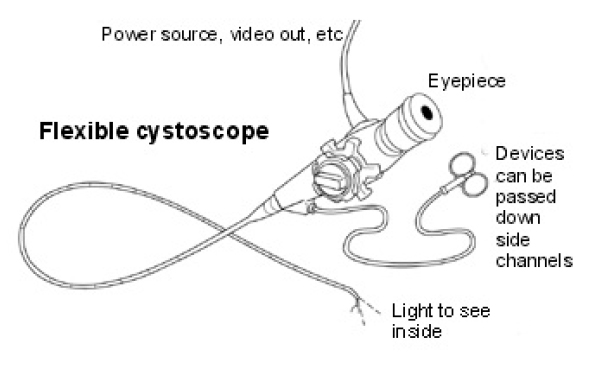Flexible cystoscopy
What is a flexible cystoscopy?
Cystoscopy is where a doctor looks into the bladder with a telescope. This is done for a number of reasons. If the telescope is fibre-optic and flexible then it is called a flexible cystoscopy.
The flexible cystoscope is a thin flexible fibre-optic telescope and is about as thin as a pencil. It has a channel to pass water down, a fibre-optic lense to see through and a working channel to pass instruments through for example to take very small biopsies.

Why have a flexible cystoscopy?
The usual reasons to have a cystoscopy are:
- To look for causes of bleed in the urine (haematuria)
- To look for bladder stones
- To check for bladder cancer under follow-up
- Occasionally to look for causes of infection
- To see if any blockages are in the urethra (stricture)
- To remove a previously placed stent (tube to the kidney)
- To place BOTOX into the bladder
What happens during a flexible cystoscopy?
A flexible cystoscopy is performed with you awake. The genital region is washed with savlon or betadine, and a lubricating gel with local anaesthetic is placed in the urethra (tube you pee through). In men two tubes of gel are used, in females one. After leaving the gel to anesthetise the urethra the scope is placed into the bladder.
This is easier in women as the urethra is short. In men as the urethra is much longer more gel is used and left in for longer, (usually 10 minutes). Despite this it will be uncomfortable as the scope passes through the prostate.
Once the telescope is in the bladder the bladder is inspected to look for any abnormal areas and biopsies taken if needed. If a video camera is being used (rather than the surgeons eye) you will be offered an opportunity to look into your own bladder
Will it hurt?
There is always some discomfort on passing the telescope into the bladder. For a female this is usually very mild. For a male the prostate area is sensitive and that part of the procedure can be uncomfortable. Although it is always hard to do as relaxing as much as possible makes it much better.
Do I need to be starved?
No, the procedure is done with you awake and with local anaesthetic gel in the urethra. You can therefore eat and drink before the procedure and drive to and from the procedure.
How long will it take?
The actual cystoscopy will take only a few minutes. As you need to get changed and as the gel is left in for a period of time you should allow 20 minutes if a female and up to 30 minutes if male.
Can I go back to work afterwards?
Yes, you can go back to work strait away but remember that it may sting a little when you pass urine for the next day or two.
What problems can occur?
The most common side effect is a burning feeling in the tube you pass urine through. Sometimes a tiny bit of blood can be seen in the first pee after the scope.
Urinary tract infections are rare but can occur sometimes. If you note:
- Strong burning pains the day after
- Bleeding
- Fever
You should contact Michael Holmes or the rooms straight away at 07 8580753.
